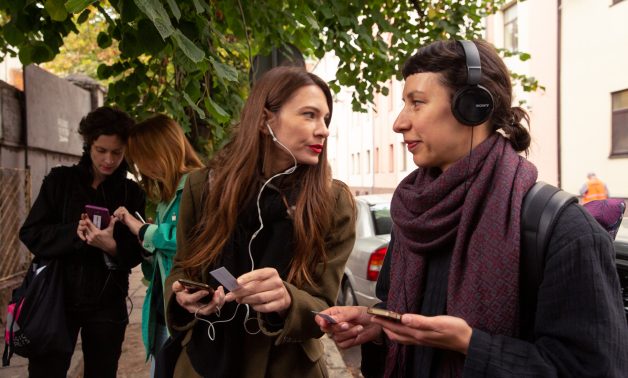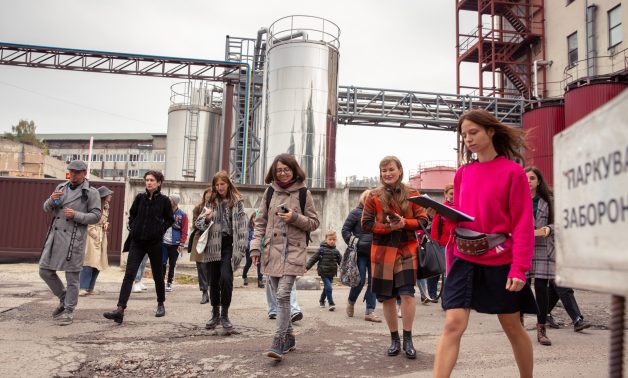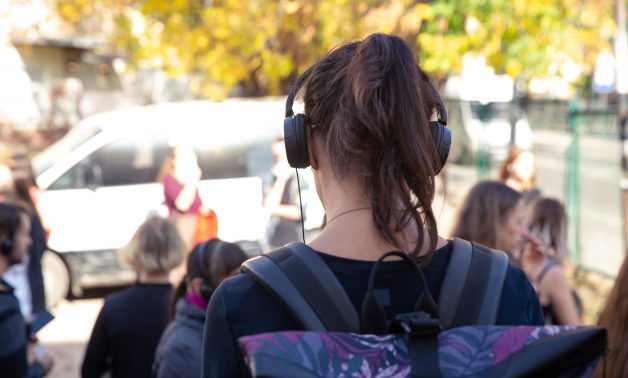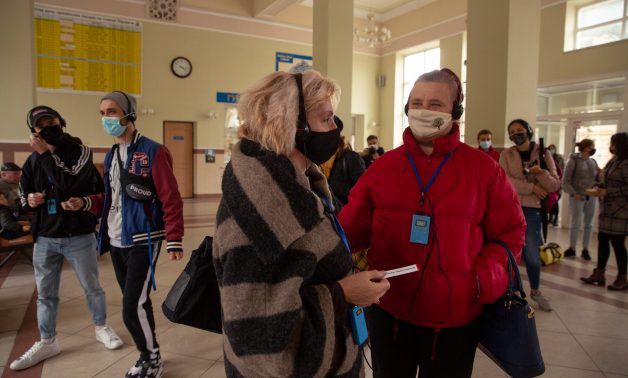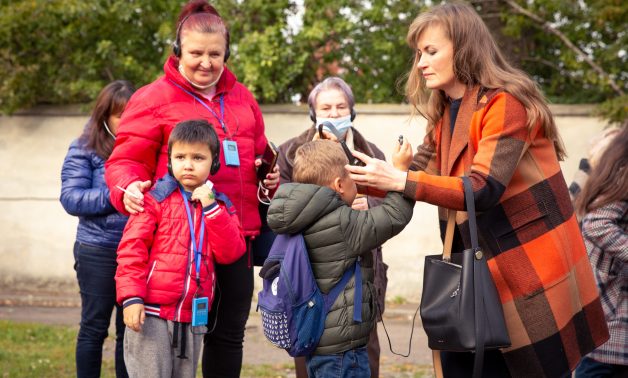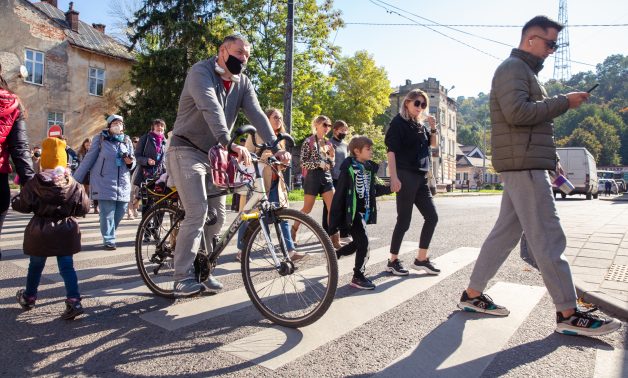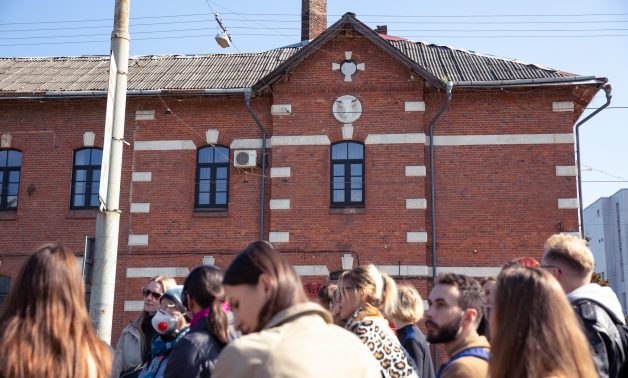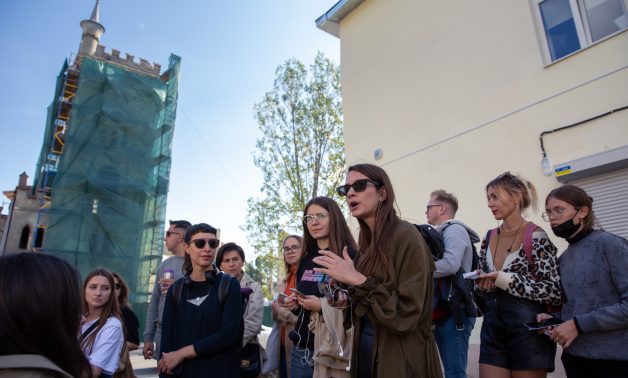1. Pidzamche Railway Station
👆 1, Ogirkova Street
Put on your headphones. Turn on the first track, close your eyes, walk around the space, go to the station and platforms.
Audio track text
The railway is and was very important for the Pidzamche neighborhood: it acted as a catalyst for industry growth but also a barrier, separating Pidzamche from the rest of the city. The Pidzamche railway station was very important for workers from all over the region traveling to numerous factories, as it was for farmers that came to sell their produce. Therefore it is a logical starting point for our audio walk. The audio file you are about to hear is a sampled collage of recorded railway station sounds, interviews with local residents, and some music composed especially for this project.
— Ternopil—Lviv electric train N 6041 arrives on the second railway line from the station. Ternopil—Lviv electric train N 6041 arrives on the second railway line from the station.
— Here is Pidzamche Station. In 1689, it used to be the Poperivskyi Cemetery, Poperivskyi Cemetery, yes. Here, well, as I said…
— May I ask you? When you came here, how did Pidzamche Station look like?
— It looked almost like now.
— Almost like now. That is…
— Why, because, in principle, it was reconstructed in 1950, yes. When I arrived, it was like that. In 2000 they did it again, well; they painted more there, yes. Well, it is exactly what it is; in fact, it connected, as it was a Lviv—Brody railway line, and it passed across the entire Lviv, well, then there was a need to build this very station.
— Well, here is Pidzamche Station, our workers were mostly from the villages. You know, it’s convenient for them, they came, yes, they arrived, and…
— All those people came, not only did they come from villages here in the Lviv region not far, people also came from villages, worked in shifts. Then they traveled from Naukova, Riasne, Levandivka, wherever.
— It was so fun, people arrived by commuter trains, went to work. Many people. Everyone arrived here, at the meatpacking plant, Svitanok firm, Raiduga.
— Yes, many.
— As the commuter train arrived, there were many people, many people. And now these factories are already closed.
Please, move to the next stop — Svitoch Chocolate Factory.
2. Svitoch Chocolate Factory (Nestle)
👆 10, Tkatska Street
Audio track text
The second stop of our audio walk is the Svitoch Chocolate factory. Industrial objects were a crucial part of the neighborhood’s identity, therefore three out of six locations of the “Tracing the memories of Pidzamche” project are industrial buildings. The Svitoch chocolate factory was mentioned many times in the interviews with the residents. Apart from the distinct smell
of chocolate that filled the area – which you can smell even today as the factory is still working, the interviewers reported various types of “under the counter” selling off pieces of chocolate which gives us an impression of how daily economics were managed in challenging times.
— Well, how, there the neighbor who was the senior, Mr. Obukhov, he worked exactly on Svitoch. He did the thing there, cognac was there, there was everything you wanted. Then he went, there were such raincoats – mackintosh, for 33 hryvnias, I remember, such, rubberized. And I was a boy, then colleagues came to me. And he climbed the stairs, fell down, he had cookies and chocolates falling out from his pockets. And we collected these. And he was cursing us out. And he fell, poor man, it started falling out of his pockets. And we, the boys, started collecting it so as the goods were preserved. Yes, there was a case. Well, what else one could do.
— Tell me again about these photos. Here you are, on the assembly line, right?
— Well, here, look, look, it, here look, see, there, there he removes. Here — already there is packing, here there is a tray of hacksaw and packing, and here remove. And here just the line goes. We stopped, that Santa Claus came and gave us presents. And on the St. Nicholas Day, it was. And do you remember that Nicholas? He was already dressed up like Nicholas, Nicholas himself, he gave us such angels, do you remember?
— And what year was it?
— As we got on Svitoch, for example, or my parents worked on Raiduha, it’s difficult. It is difficult in that respect — it was very hot on Raiduga. We had a terrible temperature on Svitoch too, the same chocolate was cooked there, cocoa butter, then they gave everything, poured it. At least it smelled there, no stink, in that sense. On Raiduha, you know. I smelled.
— This is how it is. It used to be chocolate, no one had such chocolate, as that Svitoch produced in Lviv. It smelled like chocolate, it smelled from the windows. Now it does not smell (laughter), no, because nothing works, because nothing, nothing works.
— But you probably had good smells at the factory?
— I did?
— On Svitoch, the chocolate.
— Well, of course, sure. Our chocolate was shipped around the world. It was, it was highly appreciated, our candies, ours. Nobody had competitors like us. We had no competitors. And only then, when the factory was sold, we are already working with technologies not from the factory. We are already working with substitutes. And we had natural oil, we brought cognac from Uzhhorod, from Mukachevo. Cognac is wonderful, the butter too, all that. And now there are substitutes, there are fats, it is already…
— It’s not like that anymore.
— Already Svitoch, neither candy nor chocolate not like used to be.
— How long did you work?
— I worked for 30 years, worked at Svitoch, worked for 30 years, worked at Svitoch. 30 years, child.
— And how was it?
— How was it? I worked. I got up in the morning, left at 7 o’clock, until half-past three, and worked like that. And 30 years in the same shop, at the same factory. And now I have 42 years of experience, and I have a pension — see. I’m sorry, child, but I speak as it is.
Please, move to the next stop — Meat Factory and Svitanok Leather Factory.
3. Nova Riznia (Meat Factory) and Garbarnia (Svitanok Leather Factory)
👆50-52, 54-56, 53, Promyslova Street
Audio only for 16+
Audio track text
Another industrial object that had a huge spatial and economic impact on the surrounding area is our third stop, the Meat and Leather Factory. This huge industrial complex was important not only for the food industry but also for the textile. The smell reported in the interviews was as bad as you can imagine, but don’t worry: the recreated smell of the meat and leather factory for this project focuses more on the chemicals used in the leather processing. The audio file you are about to hear is a combination of recorded interviews, environmental sounds, and composing music. I advise you to sit down and listen while looking at the space around you.
— Poltva was opened, from there, from the meatpacking plant, cows, cattle stood. We, and at that time, we were small children, we ran, looked, said: “Cows are crying”. They were standing, they were bringing them from the district, from the villages, and they were waiting here, while those telphers delivered these to the balance. Then they killed these, electrocuted, no one was cutting them. Then they killed, and then already cut and hung, they then went by telpher. Such chickens, geese, ducks. Well, there were ducks, we didn’t see them anymore, what we heard were on an onboard truck, and on top of that there was a net, the cows were open, tied to that car, so we rode standing, that’s it. And the ducks, they drove them there in that high onboard car, and the duck is low, they were not two floors. And there was a net on top, they tried to take off, you can’t tie a duck, they tied a cow. Ducks, we heard, “Ata—ta—ta” and we were near those cars. They all stood here next to each other, stood in line, accepted at loading, because they were weighed, weighed, weighed live weight, then how much of that weight goes, everything was controlled.
— And you were taught how to take it, and you were taught how to take it out, and you were taught how to put it on, and they showed you, told you where to put it. Yes, it was done that way. But there were no minuses anywhere, there were pluses everywhere. Nowhere did anyone add water, add any impurities. Because there was a sausage shop, there was milk powder, there was butter, there were melange —beaten eggs, there were whole eggs, everything went. Ah, the egg powder was still there. It was all in bags. And all this was given in sausage. Because, well, they say there, well, toilet paper. No, this is not true, it was not added. And there were no additives, whether it increased there or not. There were proportions purely process-based, put into a cutter. A cutter is a machine that cuts minced meat into sausage. There is more speed, there is less speed, it is cut, there is ground, there is milk being whipped. Strictly process-based, according to GOST it was, back then, no one added anything.
— And here, here is the smell, especially in the summer; it was awful!
— Oh, don’t even ask about that! The meatpacking plant opened the evening — there was a stench, the intestines … terrible.
Please, move to the next stop — Raiduga House of Culture.
4. Raiduga House of Culture
👆 114, B. Khmelnytskoho Street
Audio track text
Cultural centers associated with certain industries or fields of work were quite common in all socialist countries. The house of culture Raiducha was one of the neighborhood’s key points of social life, holding theatre plays, dances, and concerts. Our oldest interviewed resident even mentions going to school here. You can probably recognize the smell of old-fashioned male cologne from our project’s crafted smell. The audio file you are about to hear is a collage of various popular music and film themes that could be heard here.
— It’s a road here. Here we had a good club, we spent our yeasty years here, behind the same plant. Yes, yes, yes…
— And there was a film installation, in our club here; there was a film installation actually. So, I worked there, worked as a cashier for 10 years. There were many people here, because there were no TVs back then, nothing like that. There were so many that we had 250 seats there, and along sides and within passages, there were many children, full, full. Because there was no here, in this area, wasn’t, here, actually, wasn’t.
— Were you a batiar?
— I was a batiar, yes, I was Lviv batiar, the very concept of batiar — some people understand it as a ruffian, so they think that batiar is a ruffian. I would say that it is zbytochnyk. Batiars never did something criminal, never lead to a crime, because a ruffian is a robber, a bandit, yes.
— It was so. And then, at six o’clock, at seven o’clock there were dances, that is, dances, pure dances. And those older, teenagers were already going, they were already going to dance. Well, there were some sometimes concerts were held, some, something like that.
— Such batiar-like songs, well, that is mainly in Polish (sings) “On Kopernika street, faiduli, faiduli, faid — such a popular song, —woman beat policeman, faiduli, faiduli, fai”. Then — ruffian-like (laughs)
— It was Tuesday, Thursday, Saturday, and Sunday — there were discos. There were discos with live music. There weren’t any there, you know, no disco lights — no. People visited. And we did. You know, although it was hard, but we worked hard, because in reality, physical work was very hard, the working conditions were hard, we worked, but still, the time came — we went, there, makeup and like that, hair, whatever. There were no such cosmetics as we have now. We went. It was much more interesting and fun.
Please, move to the next stop — Food Market Pidzamche.
5. Pidzamche Food Market
👆 122, B. Khmelnytskoho Street
Audio track text
The Pidzamche marketplace was a lively area where all types of farmers’ produce were sold: fruits, vegetables, dairy products, meat, and baked goods. It was also an important part of social life where all kinds of deals were made. The smell designed for the marketplace is the most complex one in the project, as various tastes and smells were mixed in the air while the market was alive. When listening to the audio file, I recommend you to take a walk around the market stalls and imagine bringing it back to life.
— … it will be 36 hryvnias. Would you like cherries, strawberries, something?
— No, no.
— You see, it’s over. It all falls apart.
— It’s a bazaar, there is a small bazaar here. There, a couple of people will come from nearby villages, and then give it to those dealers. And then, there is Haidamatskyi bazaar, we go now, or Pryvokzalnyi we go now. There is nothing here, so we went there. Then there was a lot, there was meat and cheese. There is a pavilion empty, the windows are broken.
— On Rohatka?
— Yes, on Rohatka.
— Because we are here, and it is here, in that market, here we have already taken out that kalym. Quickly one, the other, the other sold, and that’s it.
— It is already smaller; it used to be bigger there.
— Are you going there now, too?
— My dear, almost no. Well, depends on who comes there, from the village. No, almost not. We go more often to Pryvokzalnyi or Krakivskyi.
— There are shops out there; it used to be very interesting once. Not now, it is so-so now.
Please, move to the final stop — Jam Factory Art Center.
6. Jam Factory Art Center
👆 124, B. Khmelnytskoho Street
Audio track text
Our final stop of the project is the Jam Factory. Because of its peculiar architecture, interviewed residents often reported confusion about the function of the building. As you can imagine, the strong smell of fruits was dominant. The audio file you are about to hear is a combination of field recordings, collaged interviews, and an instrumental version of a quite famous Lviv song which I hope you will recognize.
— What do you remember about the factory, well, in general, maybe when you saw it yourself, yes, or when? ..— It was a double feeling. It was originally a palace for me. I think it’s a palace.
— A palace.
— A palace. Well, a fairy tale — a princess, a palace, a knight. Something like this, very fabulous. But that’s why, for the first time, when I saw that a car was coming in, with jars rattling inside, so it didn’t work out with a princess, all that with a palace. And then, and then just passed by. That’s right, there is such a house on Bandera, a palace, you know, with such towers. I had two such in Lviv, such objects, fabulous, fantasy, there was a fantasy. Well, but what, but you know, there was even, well, a warehouse, just a warehouse.
— I will write it down for you as best I can. Here, there is a jam and vegetables, here they made jam of apples and made tomato juices, things like that. Then everything was brought here, where are you now, you say that the house is historical, well.
— And there was nothing in the shops at that time. There were queues for milk, for sour cream; there were queues for everything. There was anchovy, canned, yes. The sausage was, it was necessary to have acquaintances, from under the counter. Just the same with towels or bedding, or clothes, everything was from under the counter and only with acquaintances, so to buy something — there were terrible queues for everything. However, our productions worked.
— How so?
— Like this. Because they produced, everything they produced, everything was shipped…
— There.
— … there.
— Clear.
— And we…
— That Pidzamche area, it was such, you know, the neighboring area. The Ukrainians, the Russians, the Poles, and Jews were getting along here.
— Everyone.
— And they had no wars. There were, in fact, many Jewish synagogues here in this area.
— In our area we have nothing like, something cultural and recreational for young people. Although we have not so many young people here, but if one needs to make or even at the jam factory, or here, it will be attracting young people.
You can find more information about the Tracing the Memories of Pidzamche project here.
MagiC Carpets
“MagiC Carpets” is an international art platform created in 2017 that gives evolving artists and curators an opportunity to start their own “magical trip” by collecting local stories all around Europe and telling them in other countries through their art.
Jam Factory Art Center became a member of “MagiC Carpets” in January 2020.
For further information, visit this page
The project “MagiC Carpets” is co-financed by the EU Program “Creative Europe”.



